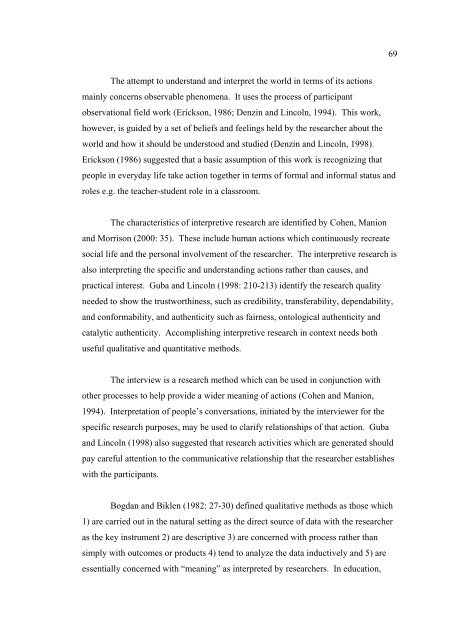an innovative approach
an innovative approach
an innovative approach
You also want an ePaper? Increase the reach of your titles
YUMPU automatically turns print PDFs into web optimized ePapers that Google loves.
The attempt to underst<strong>an</strong>d <strong>an</strong>d interpret the world in terms of its actions<br />
mainly concerns observable phenomena. It uses the process of particip<strong>an</strong>t<br />
observational field work (Erickson, 1986; Denzin <strong>an</strong>d Lincoln, 1994). This work,<br />
however, is guided by a set of beliefs <strong>an</strong>d feelings held by the researcher about the<br />
world <strong>an</strong>d how it should be understood <strong>an</strong>d studied (Denzin <strong>an</strong>d Lincoln, 1998).<br />
Erickson (1986) suggested that a basic assumption of this work is recognizing that<br />
people in everyday life take action together in terms of formal <strong>an</strong>d informal status <strong>an</strong>d<br />
roles e.g. the teacher-student role in a classroom.<br />
The characteristics of interpretive research are identified by Cohen, M<strong>an</strong>ion<br />
<strong>an</strong>d Morrison (2000: 35). These include hum<strong>an</strong> actions which continuously recreate<br />
social life <strong>an</strong>d the personal involvement of the researcher. The interpretive research is<br />
also interpreting the specific <strong>an</strong>d underst<strong>an</strong>ding actions rather th<strong>an</strong> causes, <strong>an</strong>d<br />
practical interest. Guba <strong>an</strong>d Lincoln (1998: 210-213) identify the research quality<br />
needed to show the trustworthiness, such as credibility, tr<strong>an</strong>sferability, dependability,<br />
<strong>an</strong>d conformability, <strong>an</strong>d authenticity such as fairness, ontological authenticity <strong>an</strong>d<br />
catalytic authenticity. Accomplishing interpretive research in context needs both<br />
useful qualitative <strong>an</strong>d qu<strong>an</strong>titative methods.<br />
The interview is a research method which c<strong>an</strong> be used in conjunction with<br />
other processes to help provide a wider me<strong>an</strong>ing of actions (Cohen <strong>an</strong>d M<strong>an</strong>ion,<br />
1994). Interpretation of people’s conversations, initiated by the interviewer for the<br />
specific research purposes, may be used to clarify relationships of that action. Guba<br />
<strong>an</strong>d Lincoln (1998) also suggested that research activities which are generated should<br />
pay careful attention to the communicative relationship that the researcher establishes<br />
with the particip<strong>an</strong>ts.<br />
Bogd<strong>an</strong> <strong>an</strong>d Biklen (1982: 27-30) defined qualitative methods as those which<br />
1) are carried out in the natural setting as the direct source of data with the researcher<br />
as the key instrument 2) are descriptive 3) are concerned with process rather th<strong>an</strong><br />
simply with outcomes or products 4) tend to <strong>an</strong>alyze the data inductively <strong>an</strong>d 5) are<br />
essentially concerned with “me<strong>an</strong>ing” as interpreted by researchers. In education,<br />
69
















